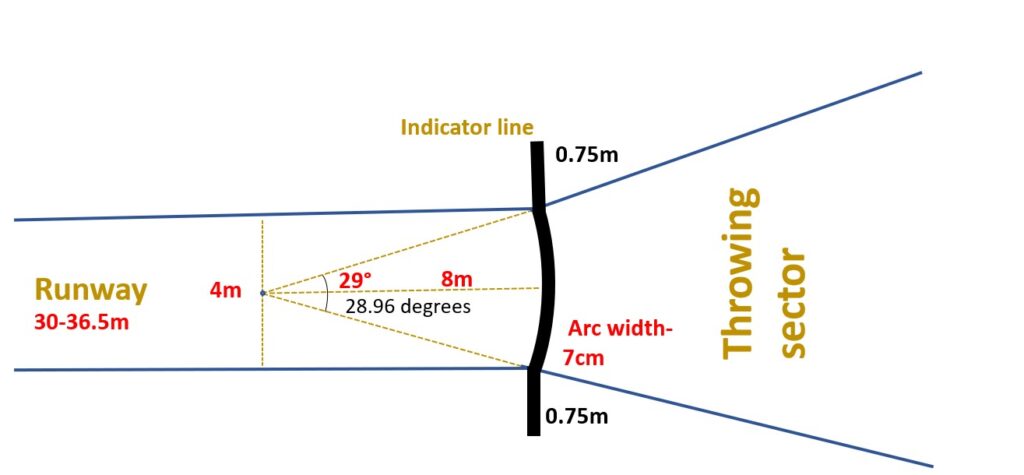Javelin Throw: Rules, and Measurements
The javelin throw is a challenging and intricate event in track and field that requires a blend of speed, power, and accuracy. This blog post will provide a detailed overview of the fundamental skills, rules, and key measurements essential for mastering the javelin throw.
History of Javelin Throw
Ancient Beginnings
The javelin throw has its origins in ancient hunting and warfare, where throwing spears for both distance and precision was a vital skill. The ancient Greeks integrated this practice into their Olympic Games around 708 BC as a component of the pentathlon.
Modern Evolution
The javelin throw was introduced into the modern Olympic Games for men in 1908 and for women in 1932. Over time, advancements in technique, equipment, and the standardization of rules have evolved the sport, establishing it as a key event in track and field athletics.
Measurements in Javelin Throw
Javelin Measurements
- Length:
- Men: 2.6 – 2.7 meters
- Women: 2.2 – 2.3 meters
- Weight:
- Men: 800 grams
- Women: 600 grams
- Cord Grip Diameter:
- Men: 25-30 mm
- Women: 20-25 mm
- Metal Head Length: 250-330 mm (Men), 250-300 mm (Women)
Runway
- Length: At least 30-36.5 meters
- Width: 4 meters
Landing Sector
- Angle: 28.96 degrees.
- Measurement: The measurement is taken from the foul line to the closest mark made by the javelin within the designated landing area.

Fundamental Skills
1. Grip
The grip is crucial for a successful throw. There are three main types of grips:
- Finish Grip: The javelin is held with the thumb and forefinger wrapped around the cord grip, providing a firm hold.
- American Grip: The javelin is held with the thumb and middle finger, with the forefinger lying along the shaft.
- Polish Grip: The javelin is held with the thumb and index finger behind the cord grip, allowing for a quick release.
2. Carry of Javelin
Proper carry of the javelin ensures balance and control. The javelin should be carried above the shoulder or head, with the tip pointing forward.
3. Cross Step
The cross step involves a series of steps to build momentum before the throw. It includes:
- Run-up: Accelerating towards the throwing line.
- Crossover steps: Quick, alternating steps to maintain speed and balance.
4. Arc of Body
The body’s arc is vital for generating the power needed for the throw. The thrower should lean back, creating a bow-like tension.
5. Release and Recovery
The release should be smooth, with the javelin leaving the hand over the shoulder. Recovery involves maintaining balance and preparing for the next throw.
Rules of Javelin Throw
Valid Throws
- Proper Grip and Throwing Technique: The javelin must be held by the grip and thrown over the shoulder or upper part of the throwing arm. It must not be slung or hurled in any other manner.
- Landing: For a throw to be valid, the metal tip of the javelin must be the first part to make contact with the ground.
- Positioning and Release: Athletes must not turn their back to the throwing sector during the approach and release phases of the throw.
Foul Throws
- Foot Faults: A throw is considered a foul if the athlete’s foot touches or crosses the throwing arc or the lines marking the sides of the runway.
- Exit Procedure: The thrower must remain within the runway lines until the javelin has landed. Exiting the runway prematurely results in a foul.
- Back Turn: Turning the back to the throwing sector before the javelin is released results in a foul.
Timing and Attempts
- Time Limit: Each athlete has one minute to complete their throw from the moment their name is called. A visible clock should indicate the remaining time, and an official will raise a yellow flag during the final 15 seconds.
- Attempts: If there are more than eight competitors, each athlete is allowed three attempts. The top eight competitors after the first three rounds are then allowed three additional attempts. If there are eight or fewer competitors, each athlete is allowed six attempts.
Measurement of Throws
- Measurement Procedure: The distance is measured from the point where the metal tip of the javelin first makes contact with the ground to the inside edge of the arc, following a straight line.
Special Circumstances
- Broken Javelin: If the javelin breaks during the throw or in the air, it does not count as a failure. The athlete is awarded a replacement trial.
- Taping and Gloves: Taping must not provide an unfair advantage and must be checked by the chief judge before the event starts. Taping two or more fingers together is not allowed, and the use of gloves is prohibited.
Officials and Their Roles
- Chief Judge: Oversees the competition, ensuring all rules are followed and resolving any disputes.
- Measurement Judges: Measure the throws accurately.
- Scorer: Records the distances of each throw.
- Time Judge: Monitors the time taken for each throw and signals the final 15 seconds.
- Announcer: Calls the names of the athletes and announces the results.
Conclusion
Mastering the javelin throw requires a combination of proper technique, adherence to rules, and physical conditioning. By understanding and practicing the fundamental skills, using the correct equipment, and following the official guidelines, athletes can excel in this challenging and rewarding track and field event.


